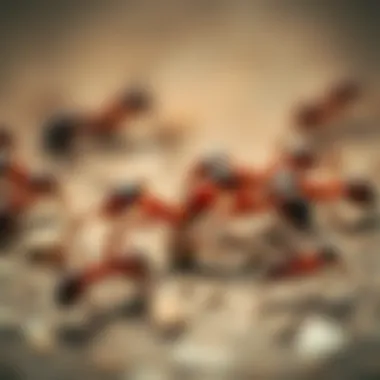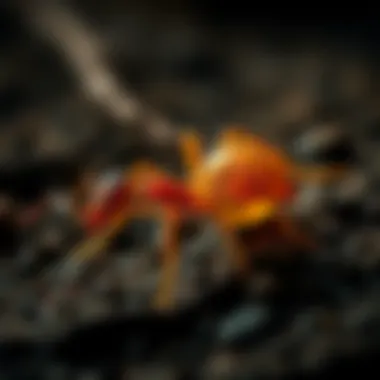Top Commercial Solutions for Fire Ant Control


Intro
Beyond just knowing how to act when faced with an infestation, it's important to grasp the biology of fire ants. Knowing your enemy is half the battle, right? Let's dive deeper into the world of fire ants, examining their life cycle and how they operate, so we can better equip you to tackle an invasion head-on.
Understanding the Pest
Identification
Identifying fire ants is the first step towards taking back control of your spaces. Typically, fire ants are reddish-brown, with workers ranging from 1/8 to 1/4 inches in size. Their mound is usually soft and not easily visible, often resembling a small hill, and can be difficult to spot when gardening or mowing. Their most notorious characteristic? A fiercely painful sting that can be pinpointed by its reddish swelling.
Life Cycle
Understanding the life cycle of fire ants is crucial. They undergo four stages: egg, larva, pupa, and adult.
- Egg: A worker ant lays eggs, and they’re tiny, white, and oval-shaped.
- Larva: Upon hatching, larvae are soft and white. They rely on the colony to feed them.
- Pupa: This stage sees them becoming a more formed ant in a cream color, still dependent on others.
- Adult: Eventually, they emerge as adult ants, ready to contribute to the colony.
The time it takes for a fire ant colony to grow varies with conditions. Keeping an eye on their life cycle can help in planning the right time to apply ant killers.
Pest Prevention Strategies
Environment Modification
Revamping your yard can play a pivotal role in pest control. Fire ants favor open areas with minimal vegetation. If you can, reduce their preferred habitats by frequently mowing grass and clearing debris. Consider using mulch wisely, as excessive mulch can serve as a perfect nesting ground for these pests.
Physical Barriers
Creating barriers can also hinder their advance. Using gravel or a stone barrier around your home may deter fire ants from entering your area. Regularly inspect for cracks or openings in your home’s foundation and seal them up. It’s always better to play it safe than sorry!
Control Methods
Chemical Control
When it comes to determining the right commercial fire ant killer, you want to choose something effective yet considerate of the environment. Among the options, Orthene Fire Ant Killer claimed for quick contact kill, while Advion Fire Ant Bait promises a slow-acting effect that eradicates entire colonies.
Biological Control
Biological methods include using beneficial nematodes that invade and kill fire ant larvae. This method is effective, promotes ecosystem balance, and reduces reliance on harsh chemicals. You might find it preferable if you're looking to maintain a green approach in your pest control efforts.
"Fire ants are not just a nuisance; they can become a serious threat to garden health and family safety if left unchecked. Knowing the right steps to take is imperative."
Arming yourself with knowledge about fire ants and choosing the right products can save you not only time and money but also bring peace of mind. A comprehensive understanding combined with practical measures leads to an efficient eradication strategy. So, stay tuned as we progress through the specifics of the most effective products on the market!
Understanding Fire Ants
Understanding fire ants is crucial, especially for homeowners trying to maintain a healthy living space. These pests are not simply a nuisance; they can wreak havoc on lawns, gardens, and, in some cases, threaten the safety of pets and children. Knowing more about fire ants helps you recognize the severity of infestations and take appropriate steps for control. Furthermore, grasping their biology, behavior, and life cycle aids in selecting the right products for eradication. Overall, it's about being informed and proactive.
Biology and Behavior of Fire Ants
Fire ants are tiny powerhouse insects. They have a hard exoskeleton, which allows them to withstand various environments. Adult fire ants generally range in color from reddish to black, with worker ants measuring about 1/8 to 1/4 inch long. Their behavior is particularly revealing; they are highly social creatures, living in colonies that can number in the thousands. One can often observe them aggressively defending their nests, particularly when disturbed.
Their foraging habits are fascinating as well. Fire ants have a strong ability to locate food sources—a characteristic that contributes to their rapid spread. Each worker ant scouts for sustenance, bringing it back to the colony. This coordinated effort can make it seem like they are swarming if one isn't careful.
Common Species of Fire Ants
Several species of fire ants infest homes and gardens, each with unique traits and behaviors. The most prominent include:
- Red Imported Fire Ant (Solenopsis invicta): Known for its painful sting, this species is especially prevalent in the southern U.S.
- Black Imported Fire Ant (Solenopsis richteri): Darker in color, this species is less aggressive but can still pose threats.
- Tropical Fire Ant (Solenopsis geminata): Often found in warmer climates, this species is notorious for creating massive mounds in open spaces.


Understanding these species helps determine the right course of action when dealing with an infestation since different species might require tailored control methods.
Identifying Fire Ant Infestations
Identifying a fire ant infestation can sometimes be easier than it appears. Look for the telltale signs: these include small mounds of soil, often with no entrance visible. Workers are usually seen marching around these mounds, collecting food and tending to their queen. Another distinct characteristic is their aggressive nature. If you disturb their nest, they tend to swarm. Watch out for painful stings that follow, which can be indicators of a nearby colony.
Important Note: If you’re not sure whether you have fire ants, consider checking for nests closely after rain, as soil disruption often exposes them.
Life Cycle of Fire Ants
Fire ants undergo a comprehensive life cycle consisting of four stages: egg, larva, pupa, and adult. The queen lays a significant number of eggs—sometimes thousands—reliably ensuring colony growth. These eggs hatch into larvae, which are cared for by workers. The larvae then pupate, transforming into adults.
The queen's health and productivity directly impact the colony. If she dies, the colony will struggle to survive. Therefore, targeting the queen becomes essential when dealing with infestations.
In summary, understanding the biology, common species, signs of infestation, and life cycle of fire ants is pivotal for effective management. With this knowledge, homeowners can make informed decisions on how to combat these formidable insects.
The Impact of Fire Ants
Understanding the impacts that fire ants have on various aspects of life is crucial for those grappling with infestations. The pervasive nature of these pests means they can influence economic factors, health standards, and pest management challenges. Knowing the depth of these impacts can inform decisions on how to effectively approach a fire ant problem.
Economic Implications of Fire Ant Infestations
Fire ants can put a strain on both personal and community finances. When they invade homes or businesses, the cost to remove them can become a hefty burden. Homeowners may need to pay for professional pest control services, which can quickly add up. Moreover, fire ants can significantly damage crops and landscaping, leading to lost revenue for farmers and garden centers. Here are some specific economic consequences to consider:
- Loss of Crop Yields: Fire ants are notorious for overrunning agricultural areas, attacking grains, fruits, and vegetables, which results in reduced crop outputs.
- Damage to Infrastructure: As they build their nests, they can compromise sidewalks and roads, leading to expensive repairs.
- Healthcare Costs: The risk of stings can lead to medical treatments that put additional financial strain on families.
In essence, fire ants don't just affect property. Their widespread presence can impact entire communities, creating economic ripples.
Health Risks Associated with Fire Ant Stings
Fire ant stings are more than just a painful nuisance; they pose real health threats. When disturbed, fire ants swarm and deliver multiple stings, which can be severe. Here are the major health risks associated with these stings:
- Allergic Reactions: Some individuals can have serious allergic responses, leading to anaphylaxis, which is potentially life-threatening.
- Infections: Stings can become infected if scratched or not treated properly, increasing health risks.
- Chronic Pain: Even for those who are not allergic, the pain and discomfort can persist longer than expected, affecting day-to-day activities.
Challenges in Fire Ant Management
Managing fire ants presents numerous obstacles. Not only are they resilient pests, but their biology also makes them tricky to eradicate. Here are some challenges many face:
- Rapid Reproduction: Fire ants reproduce quickly, making it hard to keep their population in check once they've established a colony.
- Nesting Behavior: Their preference for building nests in diverse locations means controlling them requires constant vigilance and a tailored approach.
- Resistance to Chemicals: Many fire ant species have developed a resistance to common pesticides, rendering some traditional treatments ineffective.
"Fire ants are here to stay unless proactive measures are taken. The balance between effective management and safety is critical."
To further examine the extent of fire ant infestations and their implications, seeking resources from sites such as Wikipedia or Britannica can offer additional insights.
Criteria for Selecting Fire Ant Killers
Selecting a fire ant killer isn't just about grabbing the first product you see on the store shelf. It's a decision that carries weight and consideration, especially for homeowners looking to reclaim their space. By understanding the nuances of various products, you can make an informed choice that balances effectiveness with safety.
Formulation Types
The formulation of a fire ant killer plays a crucial role in its effectiveness and suitability for different situations. Here’s a closer look:
Granular
Granular fire ant killers tend to be a popular option amongst homeowners. Their key characteristic is their ease of application; you simply sprinkle the granules in the affected area. This format has the unique advantage of providing prolonged contact with fire ants since the granules need time to dissolve and be taken into the nests.
However, there can be a downside. If conditions are too wet, the granules might wash away before having a chance to work, reducing their efficacy. Still, for those with children or pets, they provide a safer alternative, as they minimize the risk of direct exposure during application.


Liquid
Liquid formulations of fire ant killers come with their own set of perks, particularly regarding speed. Often, they can seep directly into the soil, targeting nests more effectively than granular options. When you look at a liquid killer, you'll notice it often has a faster action timeframe, meaning those pesky fire ants might meet their end within hours of application.
The downside? Liquid products can sometimes be difficult to apply evenly, and in areas with heavy rainfall or flooding, they risk dilution, which can decrease their potency. Still, if you need a quick solution, liquid options may be your best bet.
Bait
Bait-based solutions play a different game altogether. These work by enticing fire ants with a morsel they cannot resist. The ants then carry the bait back to their colony, leading to more extensive eradication. The key characteristic of bait is how it integrates into the ants' natural foraging behavior, which helps spread the active ingredient throughout the colony.
However, bait can also be a double-edged sword. If ants are not actively foraging (say, during particular seasons), the effectiveness can plummet. Furthermore, improper placement could lead to other animals snacking on the bait, leading to unintended consequences for local wildlife. Nevertheless, bait remains a compelling option for those willing to be patient and strategic.
Efficacy and Speed of Action
When choosing fire ant killers, you have to look closely at their efficacy and how quickly they work. Products that act swiftly might seem appealing, but sometimes a slower-acting approach allows for a more thorough elimination of the colony.
Safety for Humans and Pets
Safety can't be overstated. As much as one wishes to eradicate fire ants with extreme prejudice, the health of family members and pets should always be a priority. This is where reading labels and understanding potential risks becomes essential.
Environmental Impact of Chemicals
Lastly, consider the environmental implications. Some chemicals that work wonders may come with a heavy load of ramifications for plants, water sources, and even beneficial insects. It's wise to choose products that not only promise results but also align with a homeowner's commitment to protecting their immediate environment.
When it comes to tackling the persistent nuisance of fire ants, selecting an effective commercial killer is paramount. Fire ants can invade yards, gardens, and even homes, creating discomfort and health risks for families. This section delves into the top products available on the market, highlighting what makes each one stand out.
Understanding these products—and what factors influence their effectiveness—can significantly impact your pest management strategy. Often, the effectiveness of these killers can vary based on formulation, target species, and application techniques.
It’s not just about killing ants; it’s about efficiency and safety when using these products around pets and children. A responsible approach to fire ant control combines effectiveness with consideration for the environment and human health.
Product A: Features and Performance
This product boasts a granular formulation that is simple to apply. Its active ingredient is known for its fast-acting response – targeting the colony directly. Users often report noticeable reductions in ant activity within a week of application. One perk of this option is its ability to continue working for weeks after it's applied, as it remains potent in moist soil conditions. However, it requires consistent rainfall to draw the bait into the nests effectively, so timing is essential here.
Product B: Features and Performance
Product B is a liquid concentrate that offers flexibility with its application. This ready-to-use solution can be mixed with water and sprayed directly on infested areas. Its formulation includes a dual-action formula, acting quickly on contact while also offering prolonged control. Many users appreciate that it is pet-friendly once dry, making it suitable for households with animals. An important consideration is that it may take longer to see results compared to granular options, but its reach can penetrate more hidden areas of the colony.
Product C: Features and Performance
With a reputation for targeted bait effectiveness, Product C is a great option for long-term control. It specifically attracts foraging ants, who then carry the bait back to the nest, effectively spreading it throughout the colony. This method significantly reduces the entire population over time. Users have noted its effectiveness, especially in heavily infested areas, but it is worth keeping in mind that results may not be immediate; it could take several days for the ants to distribute it.
Product D: Features and Performance
Lastly, Product D is noted for its eco-friendliness. This biological control agent uses naturally occurring microbes to target and eliminate fire ant colonies. The main advantage is its low impact on non-target species and humans; however, users should be patient, as this product is not as fast-acting as its synthetic counterparts. It works best in conjunction with other methods, particularly in settings aiming for organic management.
"Biological control can be a safer option, but remember to temper your expectations regarding speed."
Application Techniques for Fire Ant Killers
When it comes to tackling a fire ant problem, just grabbing any antidote won't cut it. Effective application techniques are what make the difference between a fleeting victory and a prolonged battle. The method and timing of applying fire ant killers play a decisive role in determining how thoroughly and swiftly you will rid your space of these pesky invaders. Thus, understanding the importance of application techniques is as crucial as the choices of products themselves.
Timing and Frequency of Application
Timing is everything, especially with fire ants. If you think about it, if you hit them while they are busy scurrying about, you might miss the worker ants, which are often the ones foraging for food. Their behavior changes with the seasons and even the time of day.
- Applying killer products during the hottest part of the day can prove helpful, as the ants will be more active.
- The best time to apply is usually in the early morning or later in the evening when the heat is less oppressive, and the ants are more likely to be on the move.
- In terms of frequency, it's advisable to follow up every few weeks after the initial treatment to ensure no new queens or colonies have sprung up in the meantime.


By monitoring the situation and applying treatments as needed, you can effectively reduce the fire ant population in your vicinity.
Safety Precautions During Application
Before doing anything, it’s always smart to understand safety precautions. You'll want to ensure that you’re not just protecting yourself but also safeguarding pets and children who may wander by the application area. Here are some tips to keep in mind:
- Personal Protective Gear: Wear gloves, a mask, and long sleeves to reduce exposure to chemicals. It's reasonable to think that if you're going to wage war against these ants, you'll want to come out unscathed yourself.
- Keep Children and Pets Away: Ensure that no little feet or paws are around during the application. Since some of these products can be toxic if ingested, it's paramount to create a barrier between your home and their curious nature.
- Follow Manufacturer Instructions: Every product comes with specific application guidelines. As tempting as it might be to wing it, you definitely shouldn’t. Not adhering to these could render the treatment ineffectual or, worse, harmful.
By paying careful attention to these precautions, you can create a safer environment while dealing with fire ants.
Follow-Up Treatments and Monitoring
Once you apply a fire ant killer, don’t just sit back and relax. Following up is key to successful eradication. Fire ants are known for their resilience, and there might not be a "one-and-done" solution.
- Monitor Activity: Keep an eye on the treated area. If you start to see worker ants resurfacing or new hills forming, it may be time for another round of treatment.
- Schedule Regular Treatments: Consider establishing a weekly check-up of your property after the initial application. Implementing follow-up treatments can be more effective than waiting on the ants to simply disappear.
- Assess Environmental Changes: If the weather has shifted significantly or if you've noticed alterations in nearby landscapes (like a new garden), understand that these factors can affect fire ant activity. Adjust your treatment plans accordingly.
"The key to managing fire ants isn’t just killing them—it's understanding their patterns and implementing ongoing strategies to keep them in check."
Natural Alternatives to Chemical Killers
When it comes to tackling fire ant infestations, many people often reach for the most potent chemical killers on the market. However, relying solely on these solutions could cause more harm than good, both environmentally and to the human inhabitants of a given area. Therefore, exploring natural alternatives to chemical killers becomes essential. These alternatives not only offer effective control of fire ants but also help maintain ecological balance and promote a healthier living space.
Beneficial Insects for Fire Ant Control
One of the most promising natural alternatives involves enlisting the aid of beneficial insects. Some insects are natural predators of fire ants, creating a more balanced ecosystem. For instance, phorid flies are notorious for targeting fire ants. These small flies seek out fire ant colonies, laying their eggs inside the ants. Once the larvae hatch, they begin to consume the ant from within, ultimately thwarting the colony.
Additionally, nematodes—tiny roundworms—can also be introduced to fire ant-infested areas. These nematodes infiltrate the ant colony and cause significant mortality. By encouraging a habitat where such beneficial insects thrive, homeowners might see a significant reduction in fire ant populations without the need for harsh chemicals.
- Benefits of using beneficial insects:
- Environmentally friendly
- Minimally disruptive to other wildlife
- Long-lasting impact on fire ant populations
Unfortunately, using beneficial insects requires patience; it may take time to see a noticeable difference. However, it is an effective method for those seeking a sustainable solution.
Homemade Solutions and Eco-Friendly Methods
If you’re inclined towards a more hands-on approach, homemade solutions present another viable path. Common household items can become your allies in battling fire ants. Here are several eco-friendly methods:
- Vinegar: Mixing equal parts of vinegar and water can create a potent spray to deter fire ants. The strong scent disrupts their pheromone trails and can send them packing.
- Boiling Water: Pouring boiling water directly onto fire ant mounds can be an immediate solution to wipe out existing colonies. However, it requires caution to avoid damaging surrounding plants.
- Cinnamon: Sprinkling cinnamon around infested areas can deter fire ants due to its strong scent. This method works best as a preventive measure rather than a full-on extermination technique.
Using these homemade methods is generally safe for pets and children. Moreover, it aligns with an eco-friendly philosophy, making it a win-win for health-conscious homeowners. Remember that while homemade solutions can help, they might not eradicate fire ants completely.
Embracing natural alternatives not only protects the environment but also supports a healthier place for family and pets.
The End
In wrapping up our examination of commercial fire ant killers, it’s vital to appreciate the broader implications of managing fire ant infestations effectively. This article has gone beyond just product recommendations; it offered a look into the biology and behavior of fire ants, the economic and health challenges they pose, and the various methodologies available for control. By understanding these elements, homeowners can make more informed choices when selecting pest control solutions.
Summary of Key Points
To summarize, here are the essential elements discussed throughout the article:
- The biology and behavior of fire ants, crucial for recognizing infestations and planning a response.
- Economic implications of fire ants, highlighting the financial strain they can place on communities and households.
- Different formulations of fire ant killers, including granular, liquid, and bait options, each with unique benefits and drawbacks.
- Safety considerations for humans and pets, a non-negotiable in pest management.
- Natural alternatives that offer eco-friendly solutions without the drawbacks associated with commercial chemicals.
"Taking a multi-faceted approach to fire ant management—considering both chemical and natural solutions—can provide a balanced and effective strategy for homeowners."
Future Considerations for Fire Ant Management
As we look toward the future, it is essential to keep evolving our tactics and strategies in response to the ever-changing landscape of pest control. Here are several considerations that homeowners and pest management professionals should keep in mind:
- Integrated Pest Management (IPM): Combining various control methods, both chemical and natural, can lead to more sustainable results.
- Research and Development: Ongoing studies into the behaviors of fire ants and advancements in pest control technology could yield new products and techniques for better control.
- Community Awareness: Educating neighbors and local communities on recognizing and addressing fire ant invasions can lead to greater collective efforts, reducing infestations in larger areas.
- Regulation and Brand Development: Keep an eye on certifications and regulations regarding pest control products, as new eco-friendly brands are emerging on the market, which might better suit your needs without compromising safety.
The landscape of pest management is continuously changing. By staying informed and proactive, homeowners can become effective stewards against fire ant infestations.







